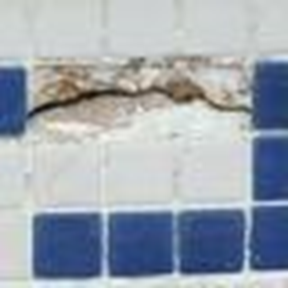- 2 Minutes to read
- Print
- PDF
2. Finishes
- 2 Minutes to read
- Print
- PDF
2.1 The sprayed concrete pool shell is a very low class of finish and tolerance and therefore requires preparation works for the liner/finishes.
2.2 Pools are designed with a clear distance between the top of the pool (underside of the coping) and the waterline – called “freeboard”.

2.3 This space allows for the displacement of water when people enter the pool and the water level rises and stop water running back under the coping and displacement of the coping tiles/pavers.
2.4 In wet (also called horizon) edge pools, the waterline is defined by the wet edge. When people enter the pool and displace water, the excess water has to go somewhere, so wet edge pools are provided with a “balance tank” which essentially is an overflow tank that fills up when the pool water is displaced.
2.5 Both types of pools can be provided with an overflow to stormwater or sewer (check with the local council where to connect the discharge) to allow pool filling from rain or the like to overflow without filling pool above the coping and then discharging around the pool. This will damage to coping and pavers/tiles to the coping.
2.6 Overflows need to be designed to Q100 where there is a risk of damage to surrounding areas if the pool overflows.
2.7 Copings are usually out of level and require a bedding of usually 20-40mm to level to pool coping (see photo left).

2.8 An issue that arises is that the water can enter the bedding and follow the cold joint between the bedding and the pool shell (see photo below).

2.9 This water can flood areas around and under the pool in suspended pool construction.
2.10 In this case a detail that prevents water tracking outside of the boundary of the pool shell requires the bedding to be sealed – similar to the detail below.

2.11 Waterline tiles require the sprayed concrete pool wall to be rendered to straighten the pool for tiles to be applied. Refer to AS3958.1 for further render details.

Above - render beneath tiles evidence at bottom of tiles.
2.12 Ensure copings and water feature walls are suitable for pools and will resist the corrosive chemically treated pool water.
2.13 Mosaic and other small format waterline tiles on backing sheets must have open weave backing sheets (not paper) and NOT be bonded with PVA glue that is water soluble. The back of the tiles needs to be free of glue and have clear tile showing to allow the tile glue to adhere correctly to the tile. Refer to the restrictions on mesh backed tiles in AS3958.1.
2.14 Pebblecrete requires a ROUGH surface to bond to. Driving equipment on and allowing constant traffic through pool shells WILL lead to pebblecrete delamination.

